
Colorado 14er
14,017
|
 |
El
Diente Traverse to Mt.
Wilson Colorado 14er 14,017 |
|||||||
|
||||||||
|
Click on any picture to enlarge it. We camped at the trailhead to Navajo Basin on a Thursday night and Friday morning hoisted our 50lb packs loaded with gear and began the hike 4.5 mile to a campsite near Navajo Lake.  The trail to Navajo Basin is quite remote and meanders through beautiful wildflower meadows and tall, dark pine forest all while gaining 2,000 feet at a more or less gentle angle - well until the final 900' climb from a river basin! We found a flat spot to pitch our tents and turned in for an early night just beating out an afternoon thunderstorm. Our plan was to climb the North Buttress (NB) based on new route information posted on 14ers.com. Last year we scouted out the normal route of a steep snow couloir up the north side of El Diente. However, the NB route was described as more stable rock - a huge attraction over 2000' of loose scree! 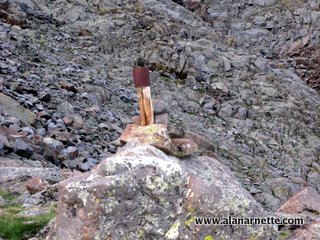 We left camp around 5:00 AM and made good time to the base of the North Buttress just as dawn lit up the route. Slightly unsure where to begin we studied the description once more and started climbing in the large boulders. Soon small cairns, some quite innovative, appeared and we knew we were at least in the right area. The climb up the NB was interesting. While we tried to follow the route, when in doubt, we just went higher; however, I am sure we did not follow the author's precise description. Overall the rock was solid as advertised and we made steady progress higher. It was mostly class 2 with sections of class 3 climbing and there were a few parts of exposed class 4 that might give pause to climbers not comfortable with air under their feet. 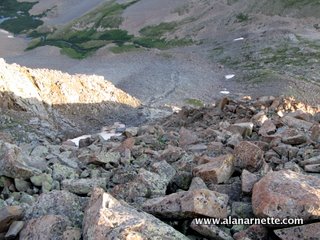
When we reached the tower and crossed a section called the slabs, we turned straight up towards the summit. Standing on the summit we could see the entire route was steeper than we thought it would be from the pictures and route descriptions. 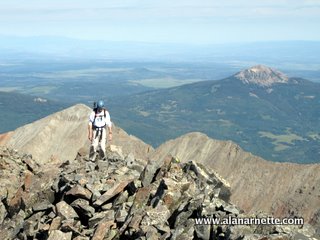
The view was excellent as always in the San Juan range and the weather appeared to be holding this mid morning. We scouted the traverse route with Mt. Wilson as the goal being about a mile away. After a quick energy bar, we left the summit for Mt. Wilson knowing we needed to pick up the pace given the recent monsoon moisture flow in the area increasing the risk of afternoon thunderstorms. The traverse climb starts off losing a bit of elevation but steadies on the south side of the ridge below impressive towering features aptly named the Organ Pipes and Gendarmes and the Narrow Section.
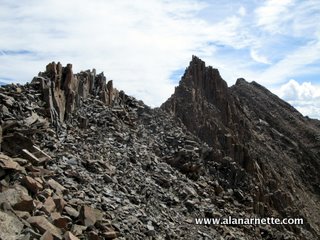 As
we reached the end of the main traverse just above the down climb to the saddle with
Wilson, the clouds began to build. Not bad, just a few white puffy ones (cumulonimbus)
but in the high mountains, you note all forms of clouds. However, a few were starting
to darken and caused us to go even faster. As
we reached the end of the main traverse just above the down climb to the saddle with
Wilson, the clouds began to build. Not bad, just a few white puffy ones (cumulonimbus)
but in the high mountains, you note all forms of clouds. However, a few were starting
to darken and caused us to go even faster.
With a quick pace we started climbing Mt. Wilson proper. This involved a somewhat steep rock and dirt couloir to the high ridge and then on to the crux of the climb; the summit block. Reaching the summit block involved class 4 climbing using hands and feet with significantly exposure. It was fun. But my mind was occupied watching the sky. Once on top, I took a video and was amazed to see a sudden rush of white, moisture laden clouds suddenly form and rise from the Kilpacker side of the ridge. In a matter of minutes, the skies went form scattered clouds to 100% covered with dark, heavy ones. I made a quick video and left quickly as I saw a sudden uplift of cloud and fog develop and move up the south side of the traverse from the valley floor.  We were about 200’ down from the summit as the clouds exploded and incredibly fast covered the entire area with heavy rain, sleet, grapple and lightening. We made a straight-line for the Navajo Basin valley via the scree but soon took cover in a large hole surrounded by boulders until the worst of the lightening passed. Wet, we returned to camp safely. 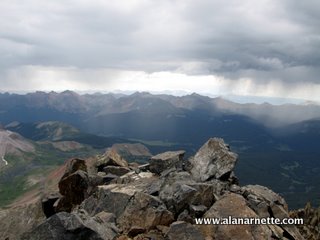
I guess we could be second guessed for continuing to climb as the first dark cloud appeared. The clouds were building but did not look that bad given we estimated about half an hour to summit and return to lower levels. In all my climbing I have never seen a storm develop so fast. It happened within a span of 5 minutes from light clouds to dark ones pouring drenching rain plus lightening. Climbing the Diente/Wilson Traverse was absolutely fantastic. Great fun with interesting challenges but nothing close to class 5, mostly high 3 with a few 4 moves here and there. It does take confidence and patience to find acceptable routes per the skills. Note: Only two days later a party of climbers were hit by a rock avalanche on the traverse, two were injured and one died from internal injuries. Speculation was that the recent heavy rains had loosened the rock. This is consistent with what we saw and experienced. Another theory was that climbers above that team created the rock fall, but this has not been supported.
Video from summit of Mt. Wilson |
|